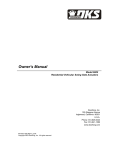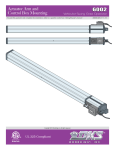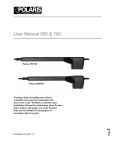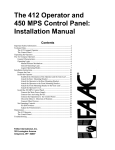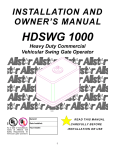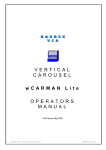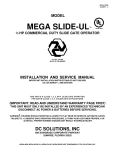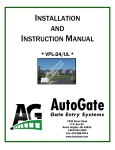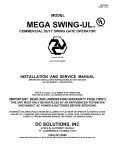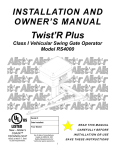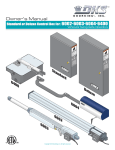Download DKS DoorKing 6400 Installation guide
Transcript
6400 underground swing gate operator - installation guide DKS , DoorKing 6400 Underground Swing Gate Operator, Installation Guide DKS DoorKing, Inc. 120 Glasgow, Avenue Inglewood, Ca. 90301 310.645.0023 310.641.1586 fax [email protected] www.doorking.com Copyright © 2006 DoorKing, Inc. All rights reserved. Notice of Rights The content in this manual is protected under copyright law and no portion of this manual may be copied, reproduced, translated, or converted to any electronic medium without prior written consent. Notice of Liability DoorKing, Inc. reserves the right to make changes in the products described in this manual without notice and/or obligation to notify any persons of any revisions or changes. DoorKing, Inc. makes no representations or warranties with respect to this manual. 1 2 underground operator installation enclosure ...................................................................... 09 gate mount ..................................................................... 11 3 electrical installation control box mounting ..................................................... 13 actuator wiring ............................................................... 14 main terminal wiring ....................................................... 15 entrapment protection wiring ......................................... 16 exit/reverse loop detector wiring .................................... 17 shadow loop detector wiring .......................................... 18 4 settings control board adjustment ............................................... 19 switch descriptions & functions ...................................... 20 limit switch adjustment ................................................... 21 reverse sensitivity adjustment ....................................... 22 soft/hard shutdown ........................................................ 23 5 technical information maintenance schedule ................................................... 24 troubleshooting .............................................................. 25 accessories .................................................................... 26 publication number 6400-065-E-05-07 general information safety instructions .....................................................04 entrapment protection ...............................................06 glossary ....................................................................07 specifications ................................................................. 08 save this installation guide for reference 1 general information / safety information Important Notice Vehicular gate operator products provide convenience and security. However, gate operators must use high levels of force to move gates and most people underestimate the power of these systems and do not realize the potential hazards associated with an incorrectly designed or installed system. These hazards may include: Pinch points Entrapment areas Reach through hazards Absence of entrapment protection devices Improperly located access controls Absence of vehicle protection devices Absence of controlled pedestrian access In addition to these potential hazards, automated vehicular gate systems must be installed in accordance with the UL-325 Safety Standard and the ASTM F2200 Construction Standard. Most people are unaware of, or are not familiar with, these standards. If an automated vehicular gate system is not properly designed, installed, used and maintained, serious injuries or death can result. Be sure that the installer has instructed you on the proper operation of the gate and gate operator system. Be sure that the installer has trained you about the basic functions of the required reversing systems associated with your gate operating system and how to test them. These include reversing loops, inherent reversing system, electric edges, photoelectric cells, or other external devices. This Owner’s Manual is your property. Keep it in a safe place for future reference. Be sure that all access control devices are installed a minimum distance of 10 feet away from the gate and gate operator, or in such a way that a person cannot touch the gate or gate operator while using the device. If access control devices are installed in violation of these restrictions, immediately remove the gate operator from service and contact your installing dealer. Loops and loop detectors, photo-cells or other equivalent devices must be installed to prevent the gate from closing on vehicular traffic. The speed limit for vehicular traffic through the gate area is 5 MPH. Install speed bumps and signs to keep vehicular traffic from speeding through the gate area. Failure to adhere to posted speed limits can result in damage to the gate, gate operator, and to the vehicle. 4 6400 installation guide Be sure that all persons who use the gate system are familiar with the proper use of the gate and gate operator and are familiar with the possible hazards associated with the gate system. Be sure that warning signs are permanently installed on both sides of the gate in an area where they are fully visible to traffic. It is your responsibility to periodically check all entrapment protection devices. If any of these devices are observed to function improperly, remove the operator from service immediately and contact your installing or servicing dealer. Follow the recommended maintenance schedule. Do not allow children to play in the area of the operator or to play with any gateoperating device To remove the gate operator from service, operate the gate to the full open position and then shut off power to the operator at the service panel. Important Safety Instructions WARNING - To reduce the risk of injury or death read and follow all instructions: 1. Never let children operate or play with gate controls. Keep the remote control away from children. 2. Always keep people and objects away from gate. NO ONE SHOULD CROSS THE PATH OF THE MOVING GATE. 3. Test the operator monthly. The gate MUST reverse on contact (contact sensors must be installed) with a rigid object or stop or reverse when an object activates the non-contact sensors. After adjusting the force or the limit of travel, retest the gate operator. Failure to adjust and retest the gate operator properly can increase the risk of injury or death. 4. Use the emergency release only when the gate is not moving. 5. KEEP GATES PROPERLY MAINTAINED. Read the owner’s manual. Have a qualified service person make repairs to gate hardware. 6. The entrance is for vehicles only. Pedestrians must use separate entrance. 7. Save these Instruction for future reference 6400-065-E-05-07 general information / safety information 1 Gate Construction Vehicular gates should be constructed and installed in accordance with ASTM F2200; Standard Specification for Automated Vehicular Gate Construction. For a copy of this standard, contact ASTM directly at 610-832-9585; [email protected]; or www.astm.org. Instructions for Intended Installation Install the gate operator only if: 1. The operator is appropriate for the construction of the gate and the usage class of the gate. 2. All openings of a horizontal slide gate are guarded or screened from the bottom of the gate to a minimum of 4 feet (1.22 m) above the ground to prevent a 2 ¼ inch (57.2 mm) diameter sphere from passing through the openings anywhere in the gate, and in that portion of the adjacent fence that the gate covers in the open position. 3. 4. All exposed pinch points are eliminated or guarded. Controls intended for user activation must be located at least ten feet (10’) away from any moving part of the gate and where the user is prevented from reaching over, under, around or through the gate to operate the controls. Outdoor or easily accessible controls should have a security feature to prevent unauthorized use. The Stop and/or Reset button must be located in the line-of-sight of the gate. Activation of the reset control shall not cause the operator to start. A minimum of two (2) WARNING SIGNS shall be installed, one on each side of the gate where easily visible. For gate operators utilizing a non-contact sensor: 1. See the instructions on the placement of non-contact sensors for each type of application. 2. Care shall be exercised to reduce the risk of nuisance tripping, such as when a vehicle trips the sensor while the gate is still moving in the opening direction. 3. One or more non-contact sensors shall be located where the risk of entrapment or obstruction exist, such as the perimeter reachable by a moving gate or barrier. Guarding is supplied for exposed rollers. The operator is intended for installation only on gates used for vehicles. Pedestrians must be supplied with a separate access opening. The pedestrian access opening shall be designed to promote pedestrian usage. Locate the gate such that persons will not come in contact with the vehicular gate during the entire path of travel of the vehicular gate. The gate must be installed in a location so that enough clearance is supplied between the gate and adjacent structures when opening and closing to reduce the risk of entrapment. Swinging gates should not open into public access areas. The gate must be properly installed and work freely in both directions prior to the installation of the gate operator. Do not over-tighten the operator clutch, pressure relief valve or reduce reversing sensitivity to compensate for a damaged gate. For gate operators utilizing contact sensors: 1. One or more contact sensors shall be located where the risk of entrapment or obstruction exist, such as at the leading edge, trailing edge, and post mounted both inside and outside of a vehicular horizontal slide gate. 2. One or more contact sensors shall be located at the bottom edge of a vehicular vertical lift gate. 3. One or more contact sensors shall be located at the pinch point of a vehicular vertical pivot gate. 4. A hardwired contact sensor shall be located and its wiring arranged so that the communication between the sensor and the gate operator is not subjected to mechanical damage. 5. A wireless contact sensor such as one that transmits radio frequency (RF) signals to the gate operator for entrapment protection functions shall be located where the transmission of the signals are not obstructed or impeded by building structures, natural landscaping or similar obstructions. A wireless contact sensor shall function under the intended end-use conditions. 6. One or more contact sensors shall be located at the bottom edge of a vertical barrier (arm). For gate operators utilizing Type D protection: 6400-065-E-05-07 1. The gate operator controls must be placed so that the user has full view of the gate area when the gate is moving. 2. A warning placard shall be placed adjacent to the controls. 3. An automatic closing device (such as a timer, loop sensor, or similar device) shall not be used. 4. No other activation device shall be connected. 6400 installation guide 5 1 general information / entrapment protection ENTRAPMENT PROTECTION Horizontal Slide, Vertical Lift,Vertical Pivot USAGE CLASS Primary Secondary Swing and Vertical Barrier (arm) Primary Secondary Vehicular I & II A B1, B2 or D A or C A, B1, B2, C or D Vehicular III A, B1 or B2 A, B1, B2, D or E A, B1, B2 or C A,B1,B2,C,D or E Vehicular IV A, B1, B2 or D A, B1, B2, D or E A, B1, B2, C or D A,B1,B2,C,D or E TYPE A: Inherent entrapment protection system. TYPE B1: Provision for connection of, or supplied with, a non-contact sensor (photoelectric sensor or the equivalent). When used as the PRIMARY device, must be monitored. TYPE B2: Provision for connection of, or supplied with, a contact sensor (edge device or the equivalent). When used as the PRIMARY device, must be monitored. TYPE C: Inherent adjustable clutch or pressure relief device. TYPE D: Provision for connection of, or supplied with, an actuating device requiring continuous pressure to maintain opening or closing motion of the gate. TYPE E: An inherent audio alarm. This vehicular gate operator is equipped with an inherent adjustable current sensing system (Type A). This system will sense an obstruction in both the opening and closing cycles causing the gate to reverse direction should an obstruction be encountered. If the system detects a second obstruction before reaching the full open or close limit after the initial reversal, an alarm will activate and the operator will need to be reset before resuming normal operation (see pages 21-23). COLUMM / PILASTER Loops and loop detectors, photo-cells and other devices must be installed with this gate operator to prevent the gate from closing on vehicular traffic. .4 ! $ 2 ! : % ! . ( :/ 42 %. % 0- Test the gate operator monthly, the gate MUST reverse or stop on contact when an object activates the inherent sensing system. After adjusting the force or the limit of travel, retest the gate operator. Failure to adjust and retest the gate operator properly can increase the risk of injury or death. If any of these functions operate improperly, remove the operator from service immediately and contact your service dealer. 4 %. 02! /.% : 4 %. Sufficient clearance should be available between the gate and adjacent structures when opening and closing to reduce the risk of entrapment. Gates should not swing into pedestrian access zones. If entrapment zone is greater than 4” inches, secondary entrapment protection is required. If entrapment zone is less than 16” inches, secondary entrapment protection is required. If clearance between the gate and adjacent structure is less than 16” inches, entrapment protection is required, if clearance is more than 16” inches, entrapment protection is not required. 6 6400 installation guide 6400-065-E-05-07 general information / glossary 1 GATE – A moving barrier such as a swinging, sliding, raising, lowering, or the like, barrier, that is a stand-alone passage barrier or is that portion of a wall or fence system that controls entrance and/or egress by persons or vehicles and completes the perimeter of a defined area. RESIDENTIAL VEHICULAR OPERATOR-CLASS – A vehicular gate operator (or system) intended for use in a home of one-to four single family dwelling, or garage or parking area associated therewith. COMMERCIAL / GENERAL ACCESS VEHICULAR OPERATOR-CLASS II – A vehicular gate operator (or system) intended for use in a commercial location or building such as a multi-family housing unit (five or more single family units), hotels, garages, retail store, or other building servicing the general public. INDUSTRIAL / LIMITED ACCESS VEHICULAR OPERATOR-CLASS III – A vehicular gate operator (or system) intended for use in an industrial location or building such as a factory or loading dock area or other locations not intended to service the general public. RESTRICTED ACCESS VEHICULAR OPERATOR-CLASS IV – A vehicular gate operator (or system) intended for use in a guarded industrial location or building such as an airport security area or other restricted access locations not servicing the general public, in which unauthorized access is prevented via supervision by security personnel. VEHICULAR BARRIER (ARM) OPERATOR (OR SYSTEM) – An operator (or system) that controls a cantilever type device (or system), consisting of a mechanical arm or barrier that moves in a vertical arc, intended for vehicular traffic flow at entrances or exits to areas such as parking garages, lots or toll areas. VEHICULAR HORIZONTAL SLIDE-GATE OPERATOR (OR SYSTEM) – A vehicular gate operator (or system) that controls a gate which slides in a horizontal direction that is intended for use for vehicular entrance and exit to a drive, parking lot, or the like. VEHICULAR SWING-GATE OPERATOR (OR SYSTEM) – A vehicular gate operator (or system) that controls a gate which moves in an arc in a horizontal plane that is intended for use for vehicular entrance and exit to a drive, parking lot, or the like. SYSTEM – In the context of these requirements, a system refers to a group of interacting devices intended to perform a common function. WIRED CONTROL – A control implemented in a form of fixed physical interconnections between the control, the associated devices, and an operator to perform predetermined functions in response to input signals. WIRELESS CONTROL – A control implemented in means other than fixed physical interconnections (such as radio waves or infrared beams) between the control, the associated devices, and an operator to perform predetermined functions in response to input signals. INHERENT ENTRAPMENT SENSOR SYSTEM – An automatic sensor system that senses entrapment of a solid object and is incorporated as a permanent and integral part of the operator. EXTERNAL ENTRAPMENT PROTECTION DEVICE – A device, examples being an edge sensor, a photoelectric sensor, or similar entrapment protection device, which provides protection against entrapment when activated and is not incorporated as a permanent part of an operator. ENTRAPMENT – The condition when an object is caught or held in a position that increases the risk of injury. 6400-065-E-05-07 6400 installation guide 7 1 general information / specifications Cover Plate Class of Operation: Class I, Underground Residential Swing Gate Actuator Type of Gate: Residential Swing Gates Only Max Torque: 300Nm Input Voltage / Operator Voltage: 24 VAC Single Phase Power Input (transformer provided) 24 VDC Crank Connecting Assembly Release Arm Current: 3 amps Gate Support Bracket Locking Bracket Cover Plate Hinges Max Gate Length: 10 Ft. Foundation Box Max Gate Weight: 300 lb. Limit Switch Plate Cycles / Hr: 20/Hr with AC Power Transformer Connected Lubrication Slot Speed: 90° in approximately 20 seconds Pinion Drain Pipe Hole Entrapment Protection: Primary - Inherent adjustable current sensor (Type A) Secondary - Provision for connection of noncontact (Type B1) sensors. 8 6400 installation guide Operator Conduit Hole 6400-065-E-05-07 underground operator installation / enclosure 1 2 Dig a hole for the enclosure box using the gate hinge as a center line, see illustration for dimensions. 2 Remove components from the foundation box before setting in to place. 1 2 .6 Gate Hinge 5 1 7 .6 6 .2 NOTE: may Dimensions differ slightly when fitting in the enclosure. NOTE: Depending on soil conditions a concrete base may need to be applied to avoid run-off. BEFORE INSTALLING THE GATE OPERATOR Review the operator specifications on page 7. Gate should be mounted on heavy-duty ball bearing hinges. Review the operator installation dimensions. Operator and gate should be installed in conjunction to ensure proper alignment when opening. Gate MUST swing freely without binding. Never attempt to manually operate any gate until the power has been shut-off unless otherwise specified. 6400-065-E-05-07 6400 installation guide 9 2 underground operator installation / enclosure 3 Place the enclosure box inside the hole ensuring it is leveled and the gate hinge is centered with the operator pivot. Gate Hinge Centered With Operator Pivot. 4 Install electrical and drainage PVC conduits: Run ectrical conduit from the foundation box to the control/junction box. Run drainage conduit from the foundation box to the nearest drain. Electrical Conduit Operator Pivot Drainage Conduit NOTE: Concrete base should be fully cured before setting the foundation box. 5 Pour concrete around the enclosure box to set in place: Cover exposed holes avoiding any concrete to seep inside the enclosure box. Confirm the operator pivot and door hinge are centered and conduits are in position. NOTE: Improper drainage will result in stagnant water leading to component failure. Pour Concrete Around the Edge of the Foundation Box. NOTE: Concrete should be fully cured before installing motor. 10 6400 installation guide 6400-065-E-05-07 underground operator installation / gate mount 1 2 2 Reinstall the motor assembly. Grease the pivot, and bearing and set components in place (see illustration for assembly installation). Pivot and Bearing DoorKing does not provide the U-CHANNEL, it must be fabricated according to existing gate dimensions. 3 Weld the gate U-Channel onto the gate support bracket. NOTE: Locking bracket and gate support should be in place at 90 degrees. Weld on both sides. Cover the components avoiding weld scale damage. 5 Crank Connecting Assembly 4 Install the gate on to the hinge and the U-Channel, gate should swing freely 90 degrees. Install the crank connecting assembly. Gate MUST be closed or at the 90 degree position when installing the crank connecting assembly. Operator configuration for biparting double door installation. 1 2 1 The output shaft of the operator MUST be oriented on the outside of the gate, the motor/ gearbox and limit assembly may have to change. 2 Remove the four nuts holding the limit bracket, loosen the magnetic limit switches and slide them 90° 3 Remove the four nuts holding the motor/gearbox, rotate the unit 180° and reinstall in the mounting box with the limit assembly. 4 The LEFT HAND motor wires connect to the PRIMARY terminals. The RIGHT HAND motor wires connect to the SECONDARY terminals. IMPORTANT: The left motor wires BROWN and BLUE are interchanged on the right side motor to BLUE and BROWN. 3 6400-065-E-05-07 6400 installation guide 11 3 electrical installation / control box mounting 1 Place the control box in the desired mounting position, mark and create the mounting holes. 2 Mount and secure the control box using appropriate hardware. Install X0REDRILLED -OUNTING(OLES the control box so that the primary actuator cable can be easily routed into the control box. 1 CONTROLBOX WHEN INSTALLING THE CONTROL BOX Be sure the circuit breaker in the electrical panel is in the OFF position. Permanent wiring must be installed to the operator as required by local electrical codes. It is recommended that a licensed electrical contractor perform this work. Check local building codes prior to installing any permanent wiring to ensure all wiring and connections comply with local electrical code requirements. Control Panel must be properly grounded. Be sure the control box is properly supported to avoid injury and damage to the control box. 1 It may be necessary to temporarily remove the control box components to avoid any damage when installing. Depending on installation it may be necessary to drill additional mounting holes in the control box. Temporarily cover the terminal strip with tape to avoid damage. 12 6400 installation guide 6400-065-E-05-07 electrical installation / actuator wiring #LOSE%DGE 3 #OMMON #OMMON 1 3%#/.$!29 Connect the PRIMARY actuator cable to the control panel as shown. BLUE (1) -/4/2 BROWN (2) -/4/2 ORANGE (3) ,)-)4 RED (4) 3,/$7. YELLOW (5) ,)-)4 3,/$7. GREEN (6) 2 Connect the SECONDARY actuator cable to the control panel as shown. GRN/WHT (YEL) 2 #/--/. #/--/. #OM MON #OM MON 3% #/ - .$!29 /4/ - 2 /4/ ,) 2 -)4 3, / ,) $7. 3, )4 / # $7. / # -/. /-/ . / - 4/2 / ,) 4/2 3, )4 / ,) $7. 3, )4 / # $7. +%9 /- -/ . -/4/2 -/4/2 ,)-)4 3,/$7. ,)-)4 3,/$7. #/--/. #/--/. BROWN (1) BLUE (2) ORANGE (3) RED (4) YELLOW (5) GREEN (6) GRN/WHT (YEL) 1 02)-!29 +%9 37)4#( 1 Primary Motor Interface Cable. 2 Secondary Motor Interface Cable. Secondary Junction Box. Previous actuators came with numbered wires. The number on the right of the wire color indicates this wiring scheme. If the cable includes a white wire, do not use or connect it. When installing electrical equipment make certain all wiring complies with local code requirements. 1 Proceed to step 2 if installing a secondary actuator . 2 Components not included, each must be purchased separately. 6400-065-E-05-07 6400 installation guide 13 3 electrical installation / main terminal wiring Function dependant on SW2, switch 1, 2 1 Function dependant on SW1, switch 5 20 24 VAC INPUT 19 24 VAC INPUT RED 12 AWG 18 24V COMMON 17 ALARM RESET 16 NOT USED 15 12V BATT + 2 14 NOT USED 13 24 VDC LOCK OUTPUT 12 24 VDC LOCK OUTPUT 11 RELAY 9 24V COMMON 10 RELAY 8 REVERSE / SHADOW INPUT 7 24V COMMON 6 OPEN INPUT 5 24V COMMON 4 OPEN INPUT / EXIT LOOP LOGIC OUTPUT 3 24V DC RADIO PWR 2 RADIO RELAY / OPEN INPUT 1 24V COMMON Function dependant on SW1, switch 3 GREEN WHITE WHITE BLACK BLACK Push Button To Call 3-Wire Telephone 115 VAC Transformer enclosure located in control box. Wire nut 115 VAC input power to Black and White transformer wires. Controls must be far enough from the gate so that the user is prevented from coming in contact with the gate while operating the controls. Outdoor or easily accessible controls should have a security feature to prevent unauthorized use. When installing electrical equipment make certain all wiring complies with local code requirements. Do not power any devices from the circuit board other than a low voltage radio receiver. 14 6400 installation guide Reversing input (Terminal 8) only functions while the gate is at the full open position or during the closing cycle should not be used as an input for a secondary entrapment protection device during the opening gate cycle. Refer to the Secondary Entrapment Protection Device Wiring section. 1 Connect optional control devices to the main terminal strip. Use 18 AWG wire for all low voltage wiring, maximum distance 3000 feet. Use a low voltage surge suppressor, (DoorKing P/N 1878-010) if low voltage wire runs exceed 1000 feet. All inputs to the terminal strip must be NORMALLY OPEN. 2 6400-065-E-05-07 electrical installation / main terminal wiring 3 TERMINAL DESCRIPTION 1. 24V COMMON 2. RADIO RELAY - SINGLE BUTTON ACTIVATION INPUT • When gate is closed, input will open gate. • When gate is open and auto close timer is turned on, input will re-set the hold timer. • When gate is open and auto close timer is turned off, input will close gate. • When gate is closing, input will reverse gate. 3. 24V DC RADIO POWER 4. SINGLE BUTTON ACTIVATION INPUT / EXIT LOOP LOGIC OUTPUT • If SW 1, switch 3 is ON, this input is identical to Single Button Activation Input (Terminal 2). • If SW 1, switch 3 is OFF, this terminal becomes the logic output of the EXIT loop detector. 5. 6. 7. 8. 24V COMMON OPEN INPUT 24V COMMON REVERSE INPUT / SHADOW INPUT • When gate is closed, this input has no affect on the gate operator. • When gate is open and auto close timer is turned ON, input will re-set and hold timer. • When gate is open and auto close timer is turned OFF, input will prevent gate from closing. • During CLOSING cycle of gate: SW 1, Switch 5 OFF = Term 8 is Reversing Input. SW 1, Switch 5 On = Term 8 is Shadow Input. Disabled During CLOSING CYCLE. 9. 24V COMMON 10. DRY RELAY CONTACT • Operation of relay is dependent on setting of SW 2, switches 1 and 2. Relay contacts can be set for Normally Open (NO) or Normally Closed (NC) operation. Contact rating is 1 amp maximum at 24 Volts. • Switch 1 OFF, Switch 2 OFF: Relay activates when gate is OPEN. • Switch 1 OFF, Switch 2 ON: Relay activates when gate is OPEN, OPENING or CLOSING. • Switch 1 ON, Switch 2 OFF: Relay activates when gate is OPEN or OPENING. • Switch 1 ON, Switch 2 ON: Relay activates when gate is OPENING or CLOSING. 11. 12. 13. 14. 15. 16. 17. 18. 19. 20. DRY RELAY CONTACT SW2 - 3 ON MAG LOCK 1 SECOND DELAY AT START SW2 - 3 OFF SOLENOID LOCK 4-5 SECOND DELAY AT START Not Used 12 VOLT BATTERY + Not Used ALARM RESET 24V COMMON 24 VAC INPUT 24 VAC INPUT *NOTE: DC power is not present on the board until the first initial cycle. 6400-065-E-05-07 6400 installation guide 15 3 electrical installation / entrapment protection wiring 1 Disconnect power to the gate operator before installing the sensors. 2 Route and connect the STANDARD REVERSE cable to the main terminal strip as shown. 3 Route and connect the PHOTO OPEN cable to the UL INPUTS as shown. 0HOTO/PEN 0HOTO#LOSE 3 /PEN%DGE #LOSE%DGE #OMMON #OMMON The swing gate operator uses an inherent entrapment sensing system (Type A) and comes equipped ready to connect a secondary entrapment protection device. Entrapment protection devices are required to reduce the risk of injury. Install sensors where the risk of entrapment or obstruction exists while gate/barrier is moving. 2 8 9 3 UL INPUTS 1 PHOTO OPEN If the open photo-beam is activated during the opening cycle, the gate will stop. The gate will remain stopped until the photo-beam input is cleared, at which time the gate will resume the open cycle. 2 2 PHOTO CLOSE If the close photo-beam input is activated during the closing cycle, the gate will stop. The gate will remain stopped until the photobeam input is cleared, at which time the gate will resume the close cycle. 3 OPEN EDGE 4 CLOSE EDGE 5 COMMON: terminal for the secondary entrapment protection device inputs. 6 COMMON 16 6400 installation guide 6400-065-E-05-07 2 Route and connect the EXIT LOOP DETECTOR cable as shown. 3 Route and connect the REVERSE LOOP DETECTOR cable as shown. TB 1 Disconnect power to the gate operator before installing the loop detector wiring. LOOP DETECTOR P/N 9406-010 LOOP P/N EXIT LOOP 3 2 TB 1 1 TB 1 electrical installation / exit/reverse loop detector wiring CTOR -010 P LOOP DETECTOR P/N 9406-010 REVERSE LOOP 3 E S R E P V O E R LO E X IT L O O P To protect the gated area from accidentally closing on vehicles a series of Loop Detectors must be installed. Loops are laid underneath, cut into asphalt or concrete driveways or buried beneath gravel and earth driveways. A Loop Detection system will sense a vehicle like a metal detector and send a signal to the gate operator preventing the gate from automatically closing on a vehicle when exiting. 6400-065-E-05-07 EXIT LOOP An exiting vehicle will activate the Exit Loop and automatically open the gate when exiting the property without having to use a transmitter or keypad. The Exit Loop can be placed 20-100 feet before the gate so that the gate is open or partially open as you drive up to it. REVERSE LOOP Will stop or reverse the close cycle of an automatic gate preventing the gate from closing while a vehicle is exiting or stopped in the gate area. Refer to the separate Loop and Loop Detectors Information Manual (Loop Info G-3-02) when installing loops. 6400 installation guide 17 3 2 Route and connect the SHADOW LOOP DETECTOR cable as shown. TB 1 TB 2 C NC NO 1 Disconnect power to the gate operator before installing the loop detector wiring. SHADOW LOOP electrical installation / shadow loop detector wiring LOOP DETECTOR P/N 9405-010 SHADOW LOOP 2%3%4 $//2+).' #/092)'(4 %8)4,//0 0HOTO/PEN 2%6%23%,//0 0HOTO#LOSE /PEN%DGE #LOSE%DGE #OMMON #OMMON 3%#/.$!29 37 -/4/2 -/4/2 ,)-)4 3,/$7. ,)-)4 3,/$7. 2%$ #(!2').' #/--/. #/--/. 4)-% -/4/2 -/4/2 ,)-)4 3,/$7. ,)-)4 3,/$7. #/--/. #/--/. '2%%. #(!2'%$ 02)-!29 +%9 37)4#( 1 2 3 4 5 6 10 11 12 13 14 15 16 17 18 19 20 11 87 899 10 1 W O D P A H O S LO A Shadow Loop is placed inside the swing gate area to prevent the gate from closing on a vehicle that is in the path of the gate after the open time has expired or the Exit Loop is too far back from the Reverse Loop. The Shadow Loop is only active when the gate is in the full open position and will not allow the swing gate to close. Once the close cycle begins the Shadow loop will not reverse the gate. 1 For correct SHADOW LOOP operation, jumper wire must be placed from terminal 9 to terminal 10. SW1 switch 5 must be OFF, SW2 switch 1 must be ON and SW2 switch 2 must be OFF. Output of Shadow Loop Detector may be connected directly to terminals 8 and 9 (dotted line - no jumper required between 9 and 10) if SW 1, switch 5 is ON. However, with this switch ON, terminal 8 becomes a shadow input (active only when the gate is FULL OPEN) and all reversing devices connected to terminal 8 will operate as shadow devices. If this is not desirable, wire the shadow loop detector as instructed above. Refer to the separate Loop and Loop Detectors Information Manual (Loop Info G-3-02) when installing loops. 18 6400 installation guide 6400-065-E-05-07 settings / control board adjustment 4 ON 1 SW1 1 2 3 4 5 6 7 8 2%3%4 %3 SW2 1 2 3 4 $//2+).' #/092)'(4 %8)4,//0 0HOTO/PEN 2%6%23%,//0 MIN 0HOTO#LOSE /PEN%DGE 1 Function Switches 2 Close Timer 3 Reverse Sensors 4 Relay Jumper MAX #LOSE%DGE 0 - 23 Seconds SW1, Switch 4 ON #OMMON #OMMON 3%#/.$!29 37 -/4/2 -/4/2 ,)-)4 3,/$7. ,)-)4 3,/$7. 2%$ #(!2').' #/--/. #/--/. 4)-% $%,!9 # #(!2'%$ 2 3, -/4/2 -/4/2 ,)-)4 3,/$7. ,)-)4 3,/$7. #/--/. #/--/. 3 -34 02)-!29 +%9 37)4#( SECONDARY 1 2 3 4 5 6 7 8 9 10 11 12 13 14 15 16 17 18 19 20 4 NC NO MIN MAX PRIMARY REVERSE SENSOR Relay Contact Setting NO - Relay Normally Open (factory) NC - Relay Normally Closed The switch settings and adjustments in this section should be made after the installation and wiring to the operator(s) is complete (see illustration). 1 6400-065-E-05-07 The two DIP-switches on the circuit board are used to program the actuators to operate in various modes and to turn on or off various operating features. Check ALL switch settings before applying power to the control panel (refer to switch settings). Whenever any programming or switch setting on the circuit board is changed, batteries must be disconnected and main power must be shut-off. Once completed turn main power on and re-connect the batteries. The new programming and settings will not take effect unless this procedure is followed. 6400 installation guide 19 4 settings / switch descriptions & functions SW1 Switch 1: Sets direction of the Primary actuator so that it cycles open upon initial power up and open command. If the actuator begins to cycle close upon initial power up and open command, turn power off and change the setting on this switch. SW1 Switch 2: Sets direction of the Secondary actuator so that it cycles open upon initial power up and open command. If the actuator begins to cycle close upon initial power up and open command, turn power off and change the setting on this switch. SW1 Switch 3: Determines if the output of the loop detector (DoorKing loop detectors only) plugged into the EXIT port will be sent directly to the microprocessor to open the gate, or if the output is directed to terminal 4 where it can then be connected to other input terminals. SW1 Switch 4: Turns the auto close timer on or off. Maximum time that the close timer can be set for is 23 seconds. SW1 Switch 5: Sets the input to terminal 8 to act as a standard reverse input (OFF) or to act as a shadow input (ON). If shadow setting is used, input to terminal 8 will only hold the gate in the full open position. Once the gate begins to close, the input will not reverse the gate. SW1 Switch 6: Turns the overlap feature on or off. When turned ON, the Secondary actuator begins its cycle 1-2 seconds prior to the Primary actuator, allowing the Primary gate to reach its full closed position 1-2 seconds before the Secondary gate. This feature is useful when a magnetic lock is used to secure the gates. SW1 Switch 7: Sets up the circuit board for single or dual (Primary / Secondary) gate operation. SW1 Switch 8: Spare switch. Leave in the OFF position. SW2 Switches 1-2: Work in conjunction with each other and determine when the relay on the board will be activated. This relay can be used as a switch for various functions such as illuminating a warning light when the gate is moving, or turning on a green light when the gate is full open. This relay is not available for these uses if it is being used for the shadow loop function. Switches 3-4: Spare switches. Leave these in the OFF position. SW2 (bottom switch) SW1 (top switch) Switch 20 6400 installation guide Function Setting Description 1 Direction Primary Set this switch so that the Primary actuator runs OPEN after 2 Direction Secondary Set this switch so that the Secondary actuator runs OPEN after initial power up and activation. 3 Exit Loop Logic Output OFF ON (normal) Output of loop detector in EXIT port is switched to terminal 4. Output of loop detector in EXIT port feeds directly to processor. 4 Auto Close Timer OFF ON Auto-close timer is OFF. Manual input required to close gate. Auto-close timer is ON. Adjustable from 1-23 seconds. 5 Reverse Shadow OFF (normal) ON Terminal 8 is STANDARD reverse input. Terminal 8 is SHADOW reverse input. 6 Overlap OFF Both actuators start at same time. ON Secondary actuator starts 1-2 seconds prior to the Primary actuator. 7 Single Dual OFF ON Switch is OFF for a single actuator. Switch is ON for two actuators (Primary / Secondary). 8 Not Used OFF Leave in OFF position. Switch 1 and 2 3 4 Function initial power up and activation. Setting Description 1-OFF 2-OFF Relay activated only when gate is FULLY OPEN Relay 1-OFF 2-ON Relay activated whenever gate is NOT CLOSED Operation 1-ON 2-OFF Relay activated when gate is OPENING or OPEN 1-ON 2-ON Relay activated when gate is OPENING or CLOSING Mag-Lock ON 1 Second Delay Solenoid OFF 4-5 Second Delay Not Used OFF LEAVE in OFF position 6400-065-E-05-07 settings / limit switch adjustment -/4/2 -/4/2 ,)-)4 3,/$7. ,)-)4 3,/$7. #/--/. #/--/. BROWN (1) BLUE (2) ORANGE (3) RED (4) YELLOW (5) GREEN (6) GRN/WHT (YEL) 02)-!29 +%9 37)4#( 4 1 Unlock the motor and set to manual. 2 Manually move the gate to the desired open or closed position. 3 Loosen the limit bolt nut and slowly slide the assembly until the LIMIT LED on the circuit board lights up. 4 Re-tighten the limits in place, lock the motor and test gate travel. Repeat steps 1-4 if required. 5 Repeat steps for the Secondary motor if required. 2 3 3 The limit switches on the motor can be adjusted to control the travel of the gate and to precisely set the full open and full closed position of the gate. This feature is especially useful in applications where the gate opens partially, such as on a curved driveway. 6400-065-E-05-07 The motor must be installed and power to the circuit board must be ON when adjusting the limit switches. 6400 installation guide 21 4 settings / reverse sensitivity adjustment 1 Activate the gate operator by pressing the keyswitch button. 2 While the gate is opening, slowly rotate the Primary Reverse Sensitivity Sensor clockwise until the gate reverses travel, back-off and reverse the sensor 1/8 turn counter clockwise. 1 2%3%4 $//2+).' #/092)'(4 %8)4,//0 0HOTO/PEN 2%6%23%,//0 0HOTO#LOSE /PEN%DGE #LOSE%DGE #OMMON #OMMON 3%#/.$!29 3 Operate the gate a few times to be sure that it cycles completely. 4 Place an immobile object along the gate path, allowing the gate to strike it while in the open or close cycle. The gate must reverse direction after striking the object. If it does not, increase the reverse sensitivity (refer to step 2) and repeat this test. Repeat steps two (2) and four (4) until the correct sensitivity has been set. 37 -/4/2 -/4/2 ,)-)4 3,/$7. ,)-)4 3,/$7. 2%$ #(!2').' #/--/. #/--/. 4)-% $%,!9 '2%%. #(!2'%$ 2 -/4/2 -/4/2 5 #/0 +%9 37)4#( 1 Actuators must be individually adjusted, repeat steps 1-4 for the Secondary actuator if required using the Secondary reverse sensitivity sensor. 9 10 11 12 13 14 15 16 17 18 19 20 1 +%9 37)4#( 4 This vehicular gate operator is equipped with an inherent adjustable reverse sensor (Type A) that is used as the primary entrapment sensing system. When sensing an obstruction in either the opening or closing gate cycle, the gate operator will reverse direction. For this system to function correctly, the gate must be properly installed and work freely in both directions. A good set of roller bearing hinges are essential for proper swing gate operation. 1 Rotating the sensitivity sensor counter-clockwise DECREASES the reverse sensitivity. Rotating the sensitivity sensor clockwise INCREASES the reverse sensitivity. 22 6400 installation guide 6400-065-E-05-07 settings / soft-hard shutdown 4 soft shutdown This occurs when the inherent or secondary entrapment protection devices are activated. In a soft shutdown condition, the operator will not respond to any input that was present when the entrapment protection device sensed an obstruction. If the gate stops at the open position, the operator will not respond to the automatic close timer (see examples below). • Example A: A time clock keys the gate open in the morning and an entrapment protection device senses an obstruction prior to the gate reaching the full open position. If the entrapment is sensed by the inherent system, the gate will reverse and run back to the closed position. The time clock input is still present, but the gate will not re-open. NOTE: In some systems, the time clock input comes from the telephone entry system relay. This same relay may also provide open commands for a card reader, MicroPLUS transmitters and the visitor telephone entry. If so, these devices will also be disabled in a soft shutdown condition. • Example B: If the gate is closing and an entrapment protection device is activated, the gate will either stop or reverse and run back to the open position, depending if the secondary or inherent device was activated. The automatic close timer will not close the gate. • Example C: Vehicle arrives at open loop and gate runs towards the open position. The inherent entrapment protection is activated. The gate reverses and runs back to the closed position. If the vehicle is still present at the open loop a soft shutdown condition does not occur. The loop input provides an immediate reset of the operator and the gate will again run to the open position. In some conditions, a soft shutdown will reset as soon as the entrapment condition clears. For example, if a non-contact sensor (photo cell) is sensing an obstruction, the operator will stop the gate and assume a soft shutdown condition. When the photocell clears, the operator will return to normal operation. When the operator is in a soft shutdown, activation of any “intended input” will reset the operator. An “intended input” includes any command, any standard safety input and any loop input. Activating any of these inputs will reset the gate. At that point the gate will return to normal operation. If the gate is open, the automatic close timer will then time out and close the gate. 2%3%4 $/ # 2ESET3WITCH hard shutdown A hard shutdown condition occurs when the inherent entrapment protection system has sensed two consecutive obstructions before the gate reaches the full open or closed position. • Example C: The gate is closing and the inherent entrapment protection system senses an obstruction and causes the gate to reverse direction, as the gate begins to run in the open direction, a second obstruction is sensed before the gate reaches the full open position, the operator will stop, the audio alarm will activate and all standard inputs are shut down (including open commands, safety commands, loop inputs, etc.). When the operator is in hard shutdown condition (audio alarm “chirps” every 5 seconds), the only way to reset the gate operator and return it to normal operation is to activate the reset button located on the top of the PC Board (see illustration above), pressing this button will reset the gate operator to normal operation, but will not activate the gate operator. An external alarm-reset switch can be mounted provided it is installed in the line of sight of the gate and gate operator. Once the gate operator has been reset, an open or close command is needed to start the gate operator. Most activating commands will cause the gate operator to cycle to the open position. This includes activation of a key switch or open command and activation of an open loop. Activation of a close command will run the gate to the closed position. NOTE: Before resetting a hard shutdown determine the cause, inspect for any obstructions that could have activated the entrapment sensing system, inspect the gate and gate hardware. Under various entrapment conditions the operator will assume either a soft or hard shutdown (alarm) condition. To determine what type of reset action is required, you will need to understand how the different entrapment conditions affect the gate operator. 6400-065-E-05-07 6400 installation guide 23 5 technical information / maintenance schedule Component Maintenance Description 3 month Activate the primary (inherent) reverse system by blocking the gate with a solid object. When the gate reverses, block the gate in the opposite direction prior to the limit being reached. The entrapment alarm should activate. Press the reset button to silence the alarm. Batteries Check the batteries for any leakage or loose connections. Batteries should be replaced every two years. Fire Dept. Check emergency vehicle access device for proper operation. Alarm Gate Inspect for damage. necessary. Check gate hinges for wear and grease if 6 month 12 month Primary Reverse System Check that the gate reverses on contact with an object in both the opening and closing cycles. Adjust the clutch if necessary. Loop(s) Check vehicular reverse and shadow loops for proper operation. Release Check manual release for proper operation. Secondary Reverse Device Check secondary (external) reverse device(s) stop or reverse the gate when activated. Complete Complete check of gate and gate operating system. NOTE: When servicing or performing any maintenance to the gate operator always check the inherent reversing system and secondary (external) reversing devices (loops, photo eyes, etc). If the inherent reversing system cannot be made operable, remove the gate operator from service until the cause of the malfunction is identified and corrected. Keeping the gate operator in service when the inherent reversing system is malfunctioning creates a hazardous condition, which can result in serious injury or death if entrapped in the gate. The gate operator should be inspected and serviced by a qualified technician anytime a malfunction is observed or suspected. High cycle usage may require more frequent service checks (see maintenance schedule). When servicing the gate operator, be sure that the 24 VAC input power, batteries are disconnected. 24 6400 installation guide 6400-065-E-05-07 technical information / troubleshooting Condition Actuator(s) will not run. Power LED is OFF. Possible Solution • • Check that power to the operator is turned ON. Check for 24 VAC at terminals 19 and 20. If voltage measures OK, check the terminal strip or replace the circuit board. • Momentarily jumper terminal 1 to terminal 2. If the input LED does not come ON, check the terminal strip or replace the circuit board. If LED does come ON, proceed to next steps. Check the fuses. • • Actuator(s) will not run. Power LED is ON. • Gate opens a short distance, then stops and reverses. • • • • • • Gate opens but will not close. • • • • • Gate closes but will not open. • • Gate starts to close, then reverses to open. • • Remove the circuit board. With two 14 AWG insulated jumper wires, momentarily jumper the battery terminals to the motor terminals (1, 2) of the Primary actuator connector. The actuator should run. Swap the two wires at the terminal strip. The actuator should run in the opposite direction. Repeat these steps using the Secondary actuator connector. If the actuator(s) run in both directions in the step above, replace the control board. If the actuator(s) do not run, or run in only one direction, problem can be a bad actuator, wire connections from the control board to the actuator(s) or a bad control board. Disconnect the gate from the actuator and check that the gate swings freely without any binding. Check the reverse sensitivity. Check the secondary safety devices. Replace the circuit board. Check the input LED’s. Any ON will hold the gate open and indicates a problem with a keying device. Check the secondary safety devices. Any activated will hold the gate open and indicates a problem with the safety device. Check the loop detectors. Any activated can hold the gate open and indicates a problem with the loop detector or ground loop. Operator may be in a “soft shutdown.” Activate any keying device to determine if operator returns to normal operation. If automatic close is desired, be sure SW1, switch 4 is ON. Operator may be in a “soft shutdown.” Check input LED’s. If any are ON, momentarily disconnect, then re-connect the wire going to the input terminal. Actuator should open. Check to be sure that the actuator is running in the proper direction. Turn power OFF, disconnect batteries and solar panels, and then back ON. Activate a keying device. Actuator should run in the open direction. If actuator runs in the close direction, turn power OFF and change direction switch SW1, switches 1 and/or 2. Re-test and reconnect batteries and solar panels. Be sure that the respective LED on the control board lights when the keying device connected to the respective terminal is activated. If LED does not light, momentarily place a jumper wire from terminal 1 to the input terminal being checked. If LED lights and gate opens, problem is with the keying device. If LED does not light, replace control board. Disconnect the gate from the actuator and check that the gate operates freely without any binding. Check the loop detector LED’s and input LED’s. Any that flash ON will cause the gate to reverse. If a shadow loop is used, check for proper wiring. A mis-wired shadow loop detector will cause the gate to reverse. • Replace the circuit board. Gate closes and then re-opens. • • Check for any input or loop detector LED’s that are ON. Check that the operator is running in the proper direction (see “gate closes but will not open” above). Alarm sounds for 5 minutes and then beeps once every 5 seconds. Operator will not run. • Operator is in a “hard shutdown” condition. Reset switch must be activated to return operator to normal operation. 6400-065-E-05-07 5 Have the following diagnostic tools available: VOM meter with minimum voltage memory or min-max range to check voltage and continuity. Meg-ohm meter capable of checking up to 500 megohms of resistance to properly check ground loop integrity. A malfunction can be isolated to one of the following: • • • Gate Operator Loop System Keying Devices. Disconnect all external inputs to the circuit board. 1. Check the input indicator LED’s. They should only come ON when a keying device (card reader, push button, etc.) is activated. If any of the input LED’s are ON continuously, this will cause the gate operator to hold open. Disconnect the keying devices one at a time until the LED goes OFF (see troubleshooting guide). 2. If the operator stops or holds open, check external secondary entrapment protection devices for any shorts or malfunction. 3. A malfunction in a loop or loop detector can cause the gate operator to hold open, or not detect a vehicle when it is present over the loop. Pull the loop detector circuit boards from the loop ports on the operator circuit board. If the malfunction persists, the problem is not with the loop system. For more information refer to the loop detector instruction sheet and the DoorKing Loop and Loop Detector Information Manual. 4. Check that there are no shorted or open control wires from the keying devices to the gate operator. If a keying device fails to open the gate, momentarily jumper across terminals 1 and 2 on the control board. If the gate operator starts, this indicates that a problem exist with the keying device and not with the gate operator. 5. Check the supply voltage and batteries. A voltage drop on the supply line (usually caused by using too small supply voltage wires) will cause the operator to malfunction. Batteries should be fully charged for proper operation, replace batteries every two years on average. 6400 installation guide 25 5 technical information / accessories The following accessories are available for 6001 / 6002 actuators. Photo Cell: Non-contact (photo-cells) sensors are used as secondary entrapment protection. EMX Industries, Inc., Model IRB-325 MMTC, Inc., Model E3K-R10K4-NR Loop Detector: Detectors plug directly into ports on circuit board. P/N 9405-010 - Single channel detector P/N 9406-010 - Two-channel detector Magnetic Lock: Magnetic locks provide secure swing gates and is a fail-safe device allowing emergency vehicle access during power outages. P/N 1216-080 or 1216-081 Time Clock: 7 day and 365 day time clocks can be used to automatically open gate at pre-set time and days. Compact clock fits inside the operator. P/N 2600-791 - 7-day clock P/N 2600-795 - 365-day clock Torsion Rods: Torsion rod assembly is used on uphill swing gates for counter balance. P/N 1203-083 Hinges: Heavy-duty ball bearing hinges provide easy swing gate operation. P/N 1200-009 - Two (2) required. Surge Devices: High and low voltage surge suppressors help prevent circuit board failure caused by lightning strikes and power surges. P/N 1876-010 - High Voltage P/N 1878-010 - Low Voltage Gate Scale: Test torque required to move gate. P/N 2600-225 Speed Bumps: Prefabricated six-foot speed bump reduces traffic speed through gate system. P/N 1610-150 Batteries: 12 Volt 3 Amp Hour P/N 1801-009 - Two (2) required Fuse: 5 Amp P/N 4601-058 26 6400 installation guide 6400-065-E-05-07 DKS DoorKing, Inc Designed by DKS, DoorKing in California 6400-065-E-05-07






























